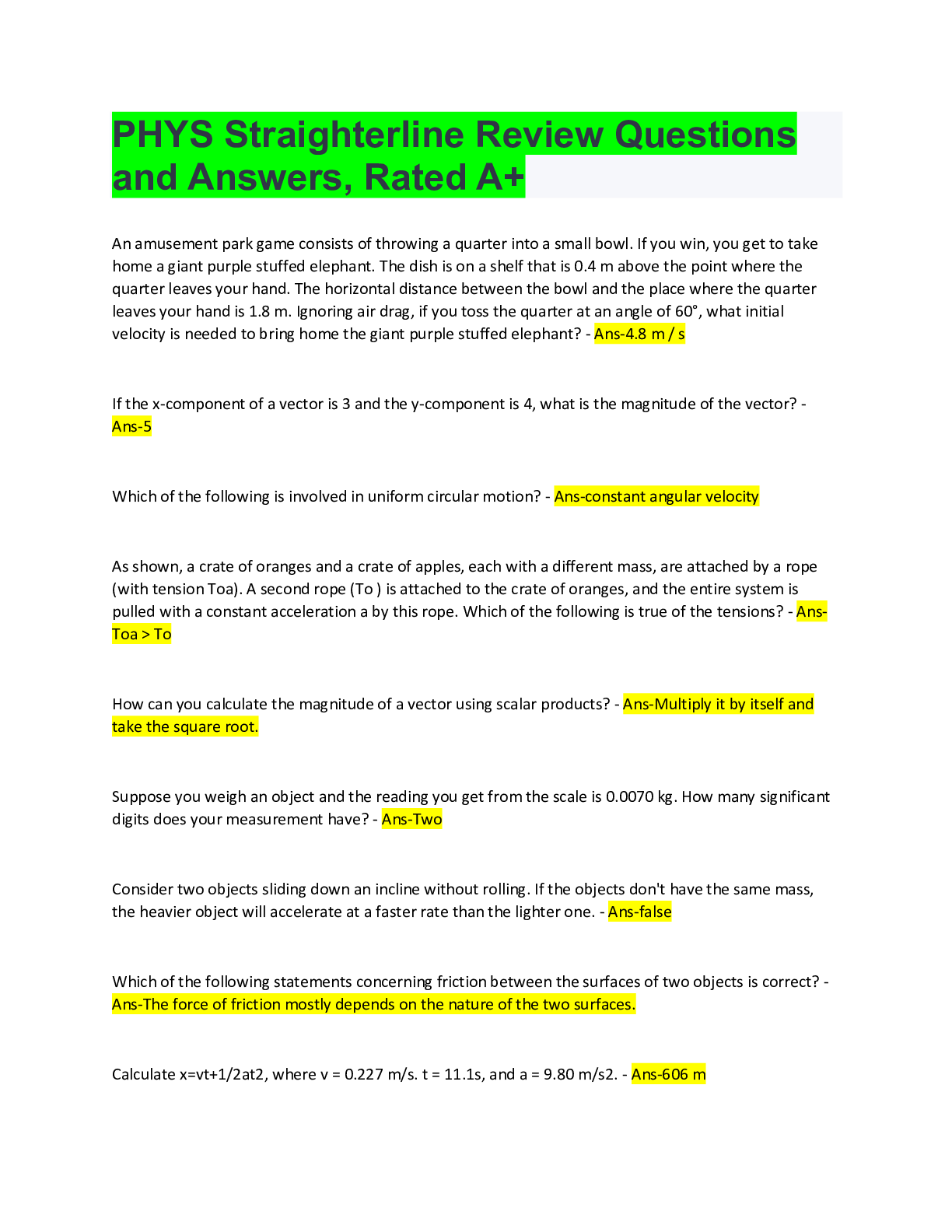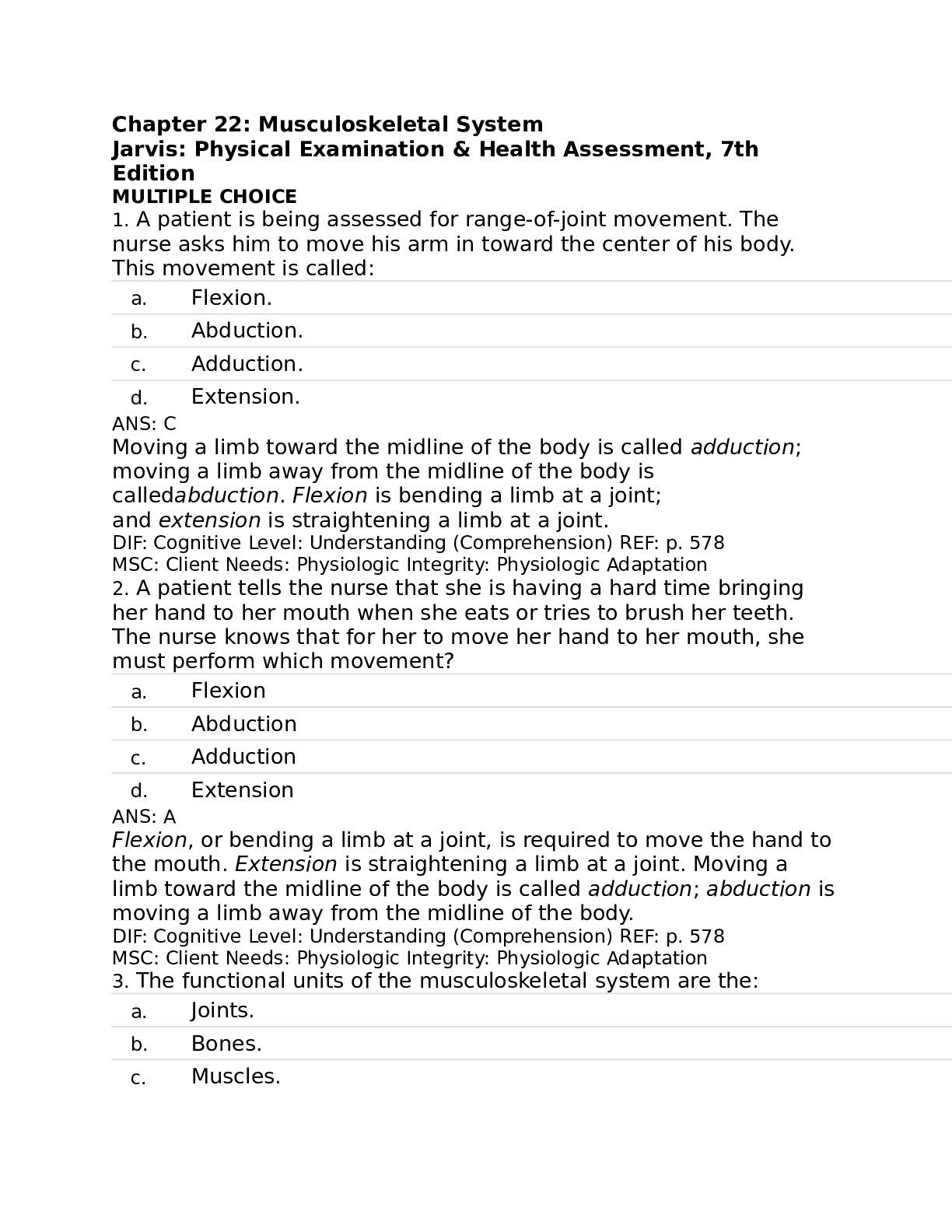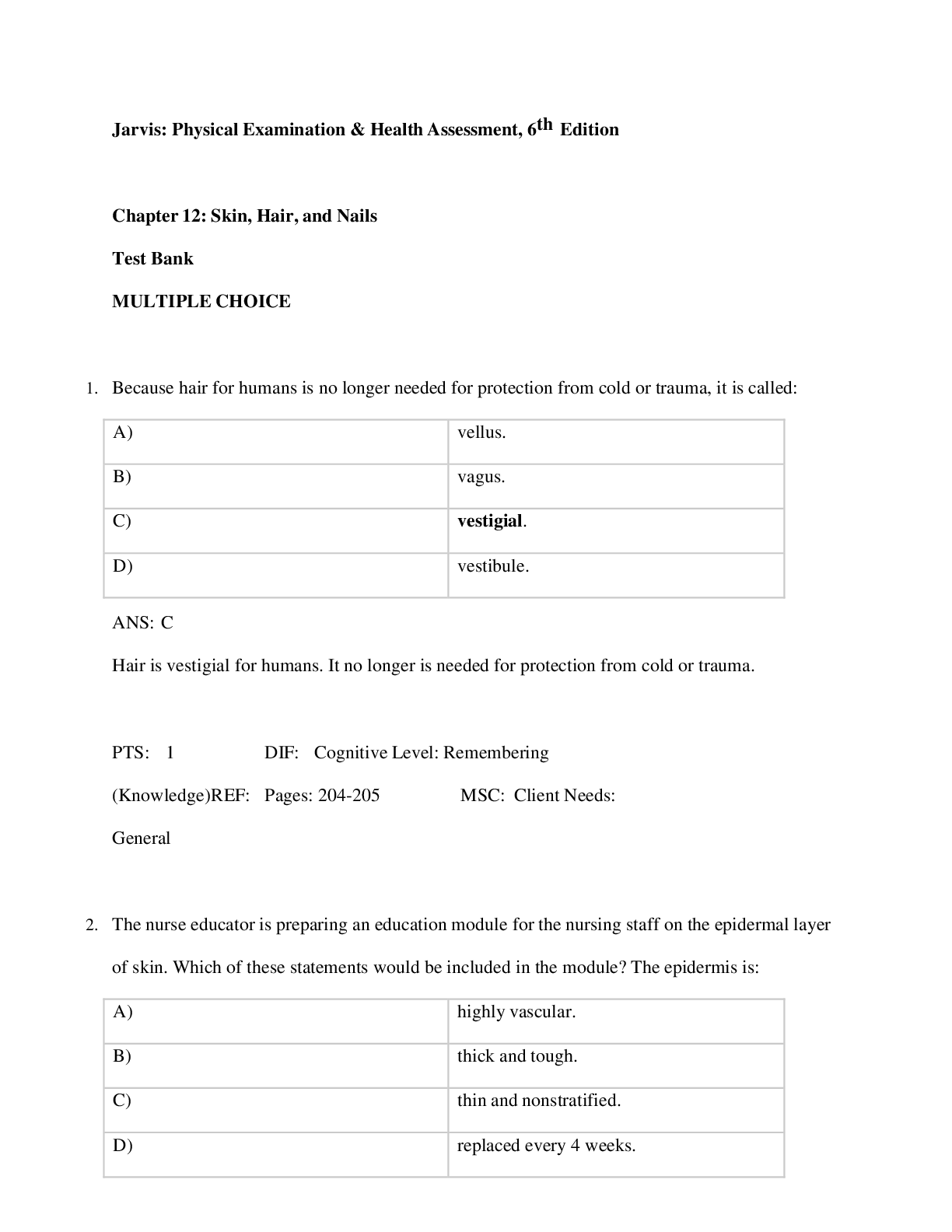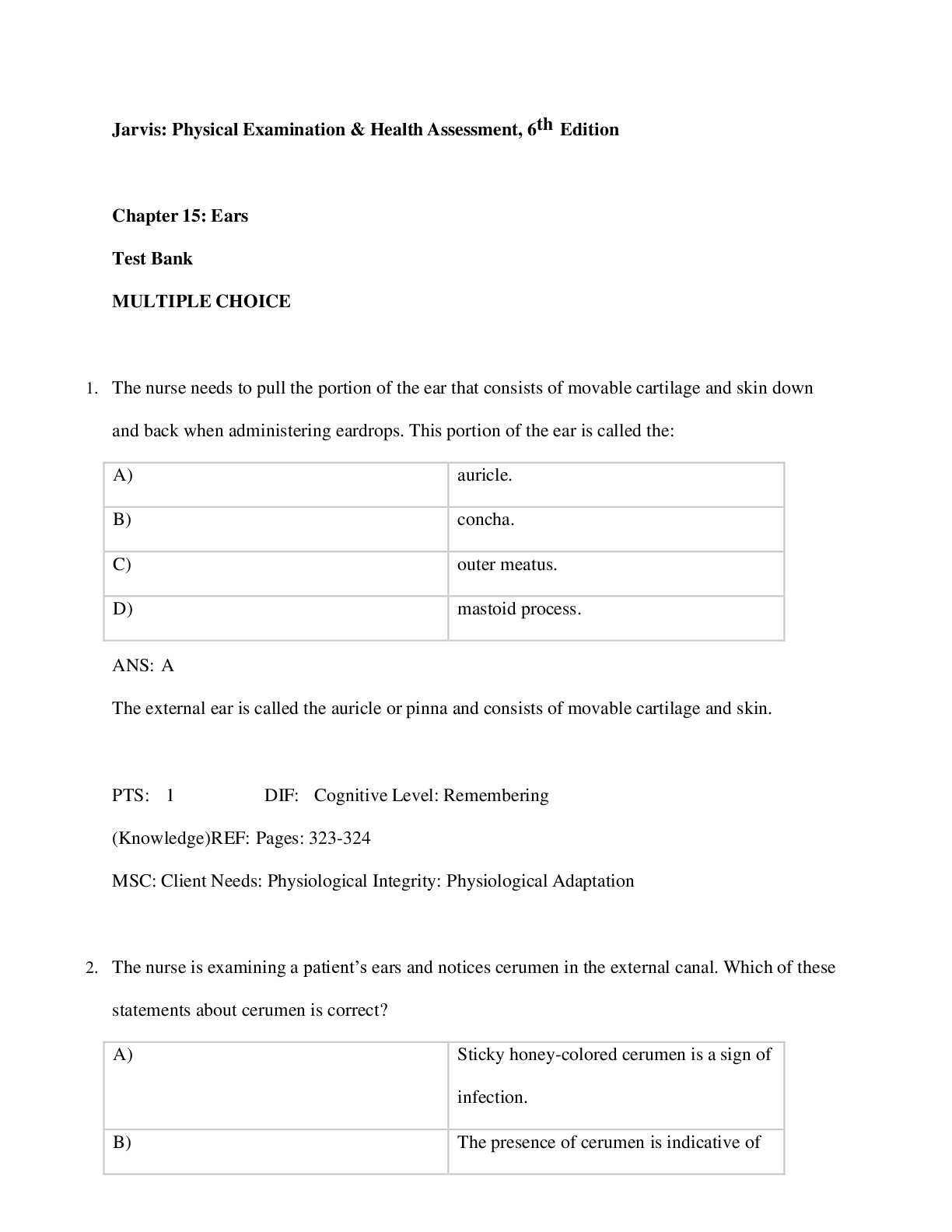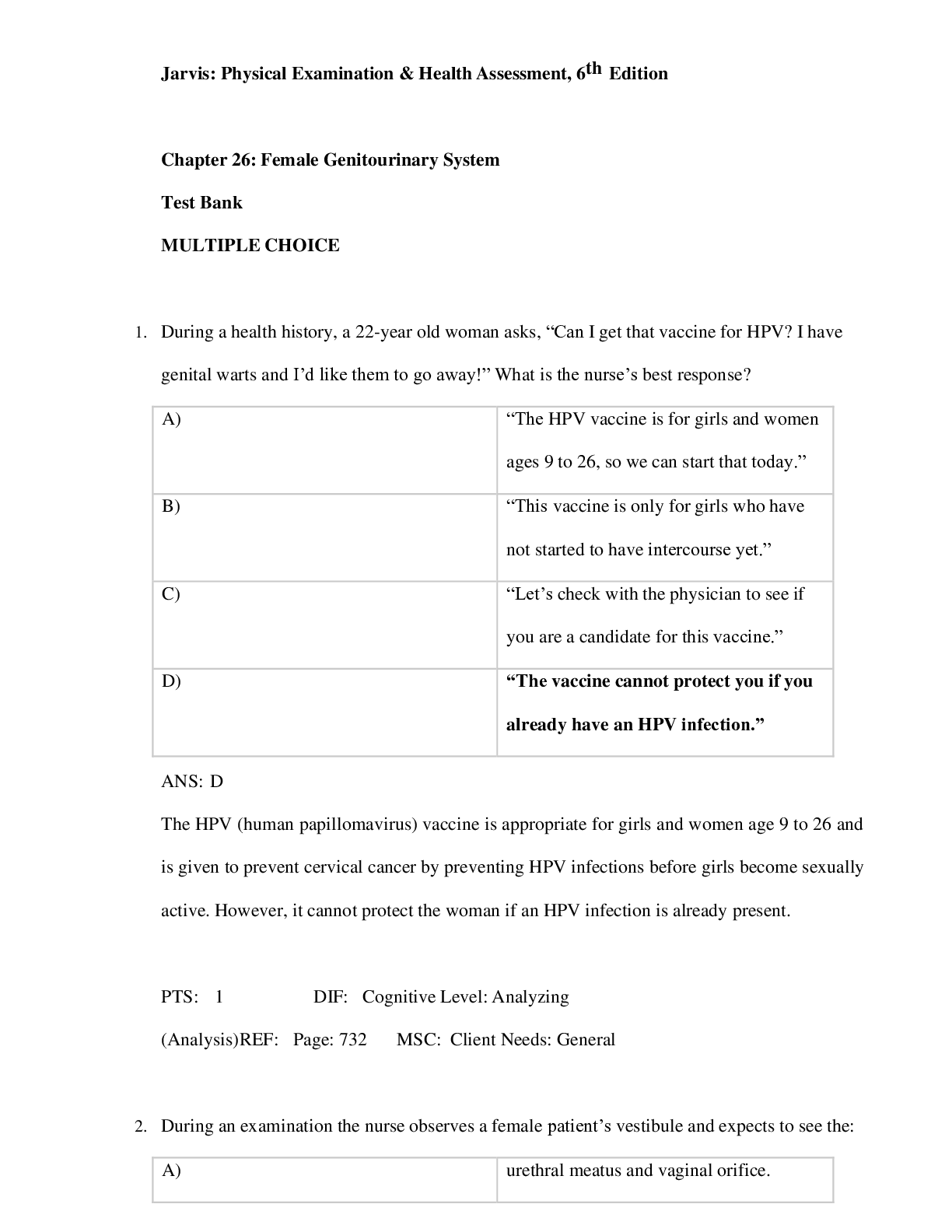*NURSING > QUESTIONS & ANSWERS > Cha-rs 12,13,14,15,16,: Jarvis: Physical Examination & Health Assessment, 7th Edition. Questions and (All)
Cha-rs 12,13,14,15,16,: Jarvis: Physical Examination & Health Assessment, 7th Edition. Questions and answers, Rated A+
Document Content and Description Below
Cha-rs 12,13,14,15,16,: Jarvis: Physical Examination & Health Assessment, 7th Edition. Questions and answers, Rated A+ 1. The nurse educator is preparing an education module for the nursing sta... ff on the epidermal layer of skin. Which of these statements would be included in the module? The epidermis is: a. Highly vascular. b. Thick and tough. c. Thin and nonstratified. d. Replaced every 4 weeks. - ✔✔D 2. The nurse educator is preparing an education module for the nursing staff on the dermis layer of skin. Which of these statements would be included in the module? The dermis: a. Contains mostly fat cells. b. Consists mostly of keratin. c. Is replaced every 4 weeks. d. Contains sensory receptors. - ✔✔D 3. The nurse is examining a patient who tells the nurse, I sure sweat a lot, especially on my face and feet but it doesnt have an odor. The nurse knows that this condition could be related to: a. Eccrine glands. b. Apocrine glands. c. Disorder of the stratum corneum. d. Disorder of the stratum germinativum. - ✔✔A 4. A newborn infant is in the clinic for a well-baby checkup. The nurse observes the infant for the possibility of fluid loss because of which of these factors? a. Subcutaneous fat deposits are high in the newborn. b. Sebaceous glands are overproductive in the newborn. c. The newborns skin is more permeable than that of the adult. d. The amount of vernix caseosa dramatically rises in the newborn. - ✔✔C 5. The nurse is bathing an 80-year-old man and notices that his skin is wrinkled, thin, lax, and dry. This finding would be related to which factor in the older adult? a. Increased vascularity of the skin b. Increased numbers of sweat and sebaceous glands c. An increase in elastin and a decrease in subcutaneous fat d. An increased loss of elastin and a decrease in subcutaneous fat - ✔✔D 6. During the aging process, the hair can look gray or white and begin to feel thin and fine. The nurse knows that this occurs because of a decrease in the number of functioning: a. Metrocytes. b. Fungacytes. c. Phagocytes. d. Melanocytes. - ✔✔D 7. During an examination, the nurse finds that a patient has excessive dryness of the skin. The best term to describe this condition is: a. Xerosis. b. Pruritus. c. Alopecia. d. Seborrhea. - ✔✔A 8. A 22-year-old woman comes to the clinic because of severe sunburn and states, I was out in the sun for just a couple of minutes. The nurse begins a medication review with her, paying special attention to which medication class? a. Nonsteroidal antiinflammatory drugs for pain b. Tetracyclines for acne c. Proton pump inhibitors for heartburn d. Thyroid replacement hormone for hypothyroidism - ✔✔B 9. A woman is leaving on a trip to Hawaii and has come in for a checkup. During the examination the nurse learns that she has diabetes and takes oral hypoglycemic agents. The patient needs to be concerned about which possible effect of her medications? a. Increased possibility of bruising b. Skin sensitivity as a result of exposure to salt water c. Lack of availability of glucose-monitoring supplies d. Importance of sunscreen and avoiding direct sunlight - ✔✔D 10. A 13-year-old girl is interested in obtaining information about the cause of her acne. The nurse should share with her that acne: a. Is contagious. b. Has no known cause. c. Is caused by increased sebum production. d. Has been found to be related to poor hygiene. - ✔✔C 11. A 75-year-old woman who has a history of diabetes and peripheral vascular disease has been trying to remove a corn on the bottom of her foot with a pair of scissors. The nurse will encourage her to stop trying to remove the corn with scissors because: a. The woman could be at increased risk for infection and lesions because of her chronic disease. b. With her diabetes, she has increased circulation to her foot, and it could cause severe bleeding. c. She is 75 years old and is unable to see; consequently, she places herself at greater risk for self-injury with the scissors. d. With her peripheral vascular disease, her range of motion is limited and she may not be able to reach the corn safely. - ✔✔A 12. The nurse keeps in mind that a thorough skin assessment is extremely important because the skin holds information about a persons: a. Support systems. b. Circulatory status. c. Socioeconomic status. d. Psychological wellness. - ✔✔B 13. A patient comes in for a physical examination and complains of freezing to death while waiting for her examination. The nurse notes that her skin is pale and cool and attributes this finding to: a. Venous pooling. b. Peripheral vasodilation. c. Peripheral vasoconstriction. d. Decreased arterial perfusion. - ✔✔C 14. A patient comes to the clinic and tells the nurse that he has been confined to his recliner chair for approximately 3 days with his feet down and he asks the nurse to evaluate his feet. During the assessment, the nurse might expect to find: a. Pallor b. Coolness c. Distended veins d. Prolonged capillary filling time - ✔✔C 15. A patient is especially worried about an area of skin on her feet that has turned white. The health care provider has told her that her condition is vitiligo. The nurse explains to her that vitiligo is: a. Caused by an excess of melanin pigment b. Caused by an excess of apocrine glands in her feet c. Caused by the complete absence of melanin pigment d. Related to impetigo and can be treated with an ointment - ✔✔C 16. A patient tells the nurse that he has noticed that one of his moles has started to burn and bleed. When assessing his skin, the nurse pays special attention to the danger signs for pigmented lesions and is concerned with which additional finding? a. Color variation b. Border regularity c. Symmetry of lesions d. Diameter of less than 6 mm - ✔✔A 17. A patient comes to the clinic and states that he has noticed that his skin is redder than normal. The nurse understands that this condition is due to hyperemia and knows that it can be caused by: a. Decreased amounts of bilirubin in the blood b. Excess blood in the underlying blood vessels c. Decreased perfusion to the surrounding tissues d. Excess blood in the dilated superficial capillaries - ✔✔D 18. During a skin assessment, the nurse notices that a Mexican-American patient has skin that is yellowish-brown; however, the skin on the hard and soft palate is pink and the patients scleras are not yellow. From this finding, the nurse could probably rule out: a. Pallor b. Jaundice c. Cyanosis d. Iron deficiency - ✔✔B 19. A black patient is in the intensive care unit because of impending shock after an accident. The nurse expects to find what characteristics in this patients skin? a. Ruddy blue. b. Generalized pallor. c. Ashen, gray, or dull. d. Patchy areas of pallor. - ✔✔C 20. An older adult woman is brought to the emergency department after being found lying on the kitchen floor for 2 days; she is extremely dehydrated. What would the nurse expect to see during the examination? a. Smooth mucous membranes and lips b. Dry mucous membranes and cracked lips c. Pale mucous membranes d. White patches on the mucous membranes - ✔✔B 21. A 42-year-old woman complains that she has noticed several small, slightly raised, bright red dots on her chest. On examination, the nurse expects that the spots are probably: a. Anasarca. b. Scleroderma. c. Senile angiomas. d. Latent myeloma. - ✔✔C 22. A 65-year-old man with emphysema and bronchitis has come to the clinic for a follow-up appointment. On assessment, the nurse might expect to see which finding? a. Anasarca b. Scleroderma c. Pedal erythema d. Clubbing of the nails - ✔✔D 23. A newborn infant has Down syndrome. During the skin assessment, the nurse notices a transient mottling in the trunk and extremities in response to the cool temperature in the examination room. The infants mother also notices the mottling and asks what it is. The nurse knows that this mottling is called: a. Caf au lait. b. Carotenemia. c. Acrocyanosis. d. Cutis marmorata. - ✔✔D 24. A 35-year-old pregnant woman comes to the clinic for a monthly appointment. During the assessment, the nurse notices that she has a brown patch of hyperpigmentation on her face. The nurse continues the skin assessment aware that another finding may be: a. Keratoses. b. Xerosis. c. Chloasma. d. Acrochordons. - ✔✔C 25. A man has come in to the clinic for a skin assessment because he is worried he might have skin cancer. During the skin assessment the nurse notices several areas of pigmentation that look greasy, dark, and stuck on his skin. Which is the best prediction? a. Senile lentigines, which do not become cancerous b. Actinic keratoses, which are precursors to basal cell carcinoma c. Acrochordons, which are precursors to squamous cell carcinoma d. Seborrheic keratoses, which do not become cancerous - ✔✔D 26. A 70-year-old woman who loves to garden has small, flat, brown macules over her arms and hands. She asks, What causes these liver spots? The nurse tells her, They are: a. Signs of decreased hematocrit related to anemia. b. Due to the destruction of melanin in your skin from exposure to the sun. c. Clusters of melanocytes that appear after extensive sun exposure. d. Areas of hyperpigmentation related to decreased perfusion and vasoconstriction. - ✔✔C 27. The nurse notices that a patient has a solid, elevated, circumscribed lesion that is less than 1 cm in diameter. When documenting this finding, the nurse reports this as a: a. Bulla. b. Wheal. c. Nodule. d. Papule. - ✔✔D 28. The nurse just noted from the medical record that the patient has a lesion that is confluent in nature. On examination, the nurse expects to find: a. Lesions that run together. b. Annular lesions that have grown together. c. Lesions arranged in a line along a nerve route. d. Lesions that are grouped or clustered together. - ✔✔A 29. A patient has had a terrible itch for several months that he has been continuously scratching. On examination, the nurse might expect to find: a. A keloid. b. A fissure. c. Keratosis. d. Lichenification. - ✔✔D 30. A physician has diagnosed a patient with purpura. After leaving the room, a nursing student asks the nurse what the physician saw that led to that diagnosis. The nurse should say, The physician is referring to the: a. Blue dilation of blood vessels in a star-shaped linear pattern on the legs. b. Fiery red, star-shaped marking on the cheek that has a solid circular center. c. Confluent and extensive patch of petechiae and ecchymoses on the feet. d. Tiny areas of hemorrhage that are less than 2 mm, round, discrete, and dark red in color. - ✔✔C 31. A mother has noticed that her son, who has been to a new babysitter, has some blisters and scabs on his face and buttocks. On examination, the nurse notices moist, thin-roofed vesicles with a thin erythematous base and suspects: a. Eczema. b. Impetigo. c. Herpes zoster. d. Diaper dermatitis. - ✔✔B 32. The nurse notices that a school- [Show More]
Last updated: 1 year ago
Preview 1 out of 20 pages
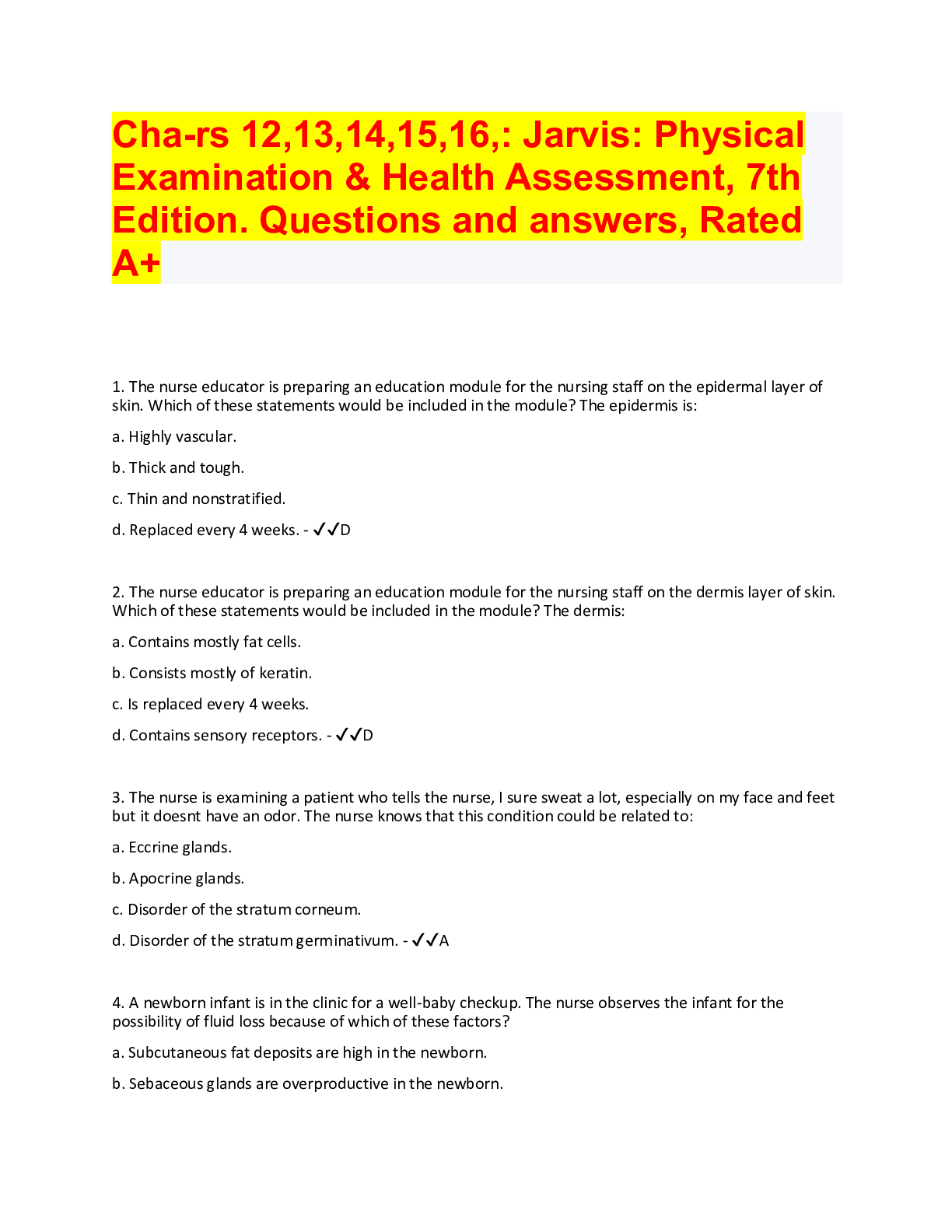
Also available in bundle (1)
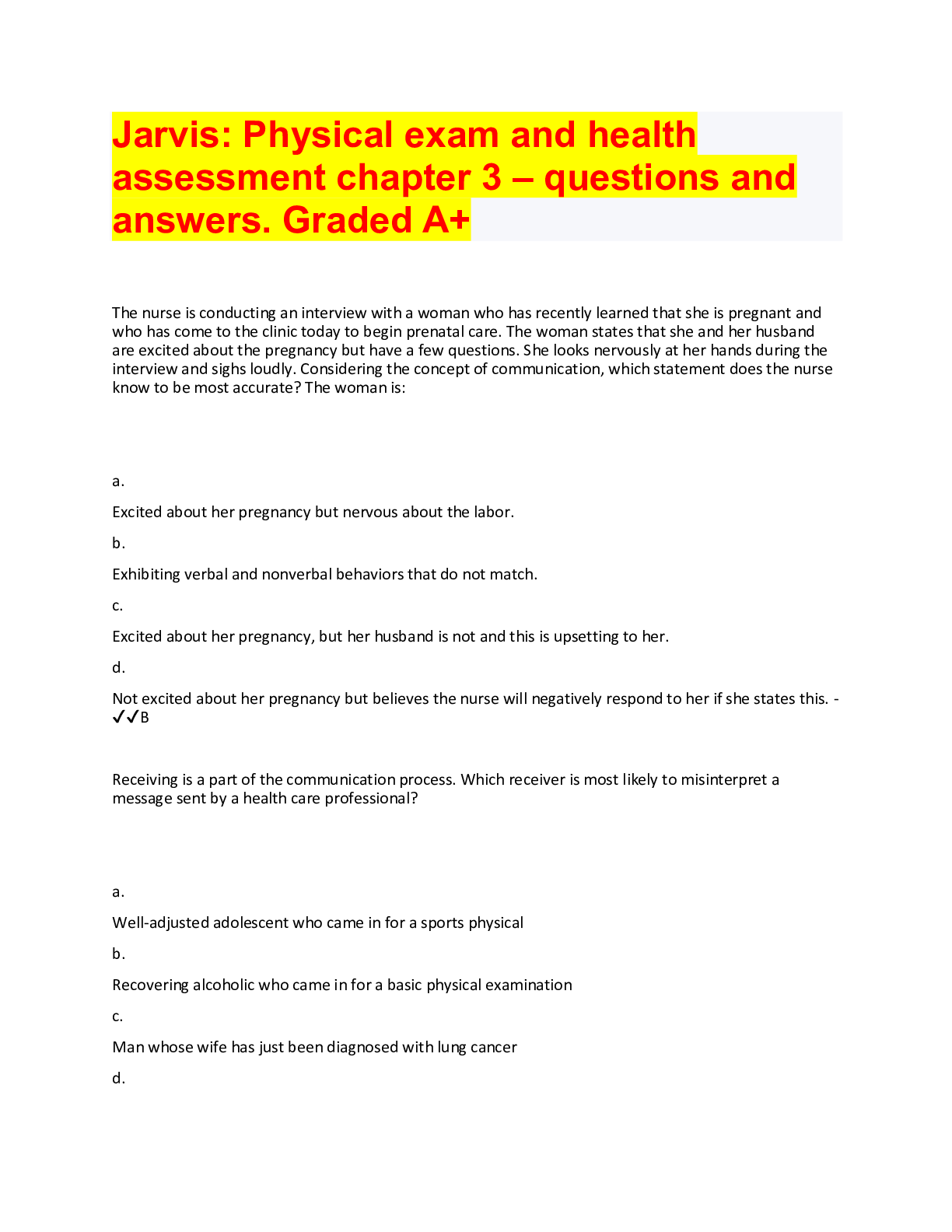
Jaarvis Bundle, Latest updates 2022.
This bindle comprises of all the Jarvis exam questions and answers documents, Graded A+.
By bundleHub Solution guider 1 year ago
$40
20
Reviews( 0 )
Document information
Connected school, study & course
About the document
Uploaded On
Aug 23, 2022
Number of pages
20
Written in
Additional information
This document has been written for:
Uploaded
Aug 23, 2022
Downloads
0
Views
97




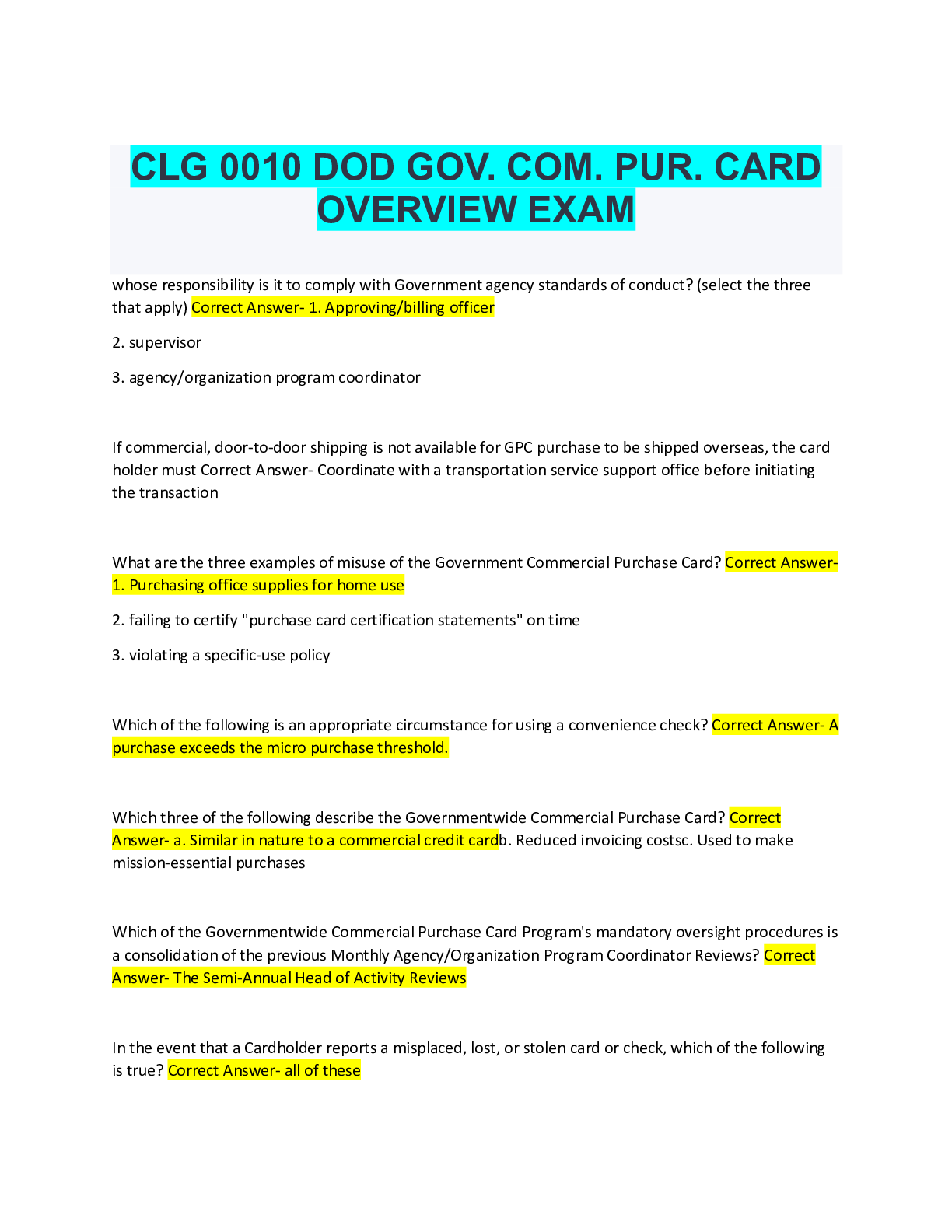


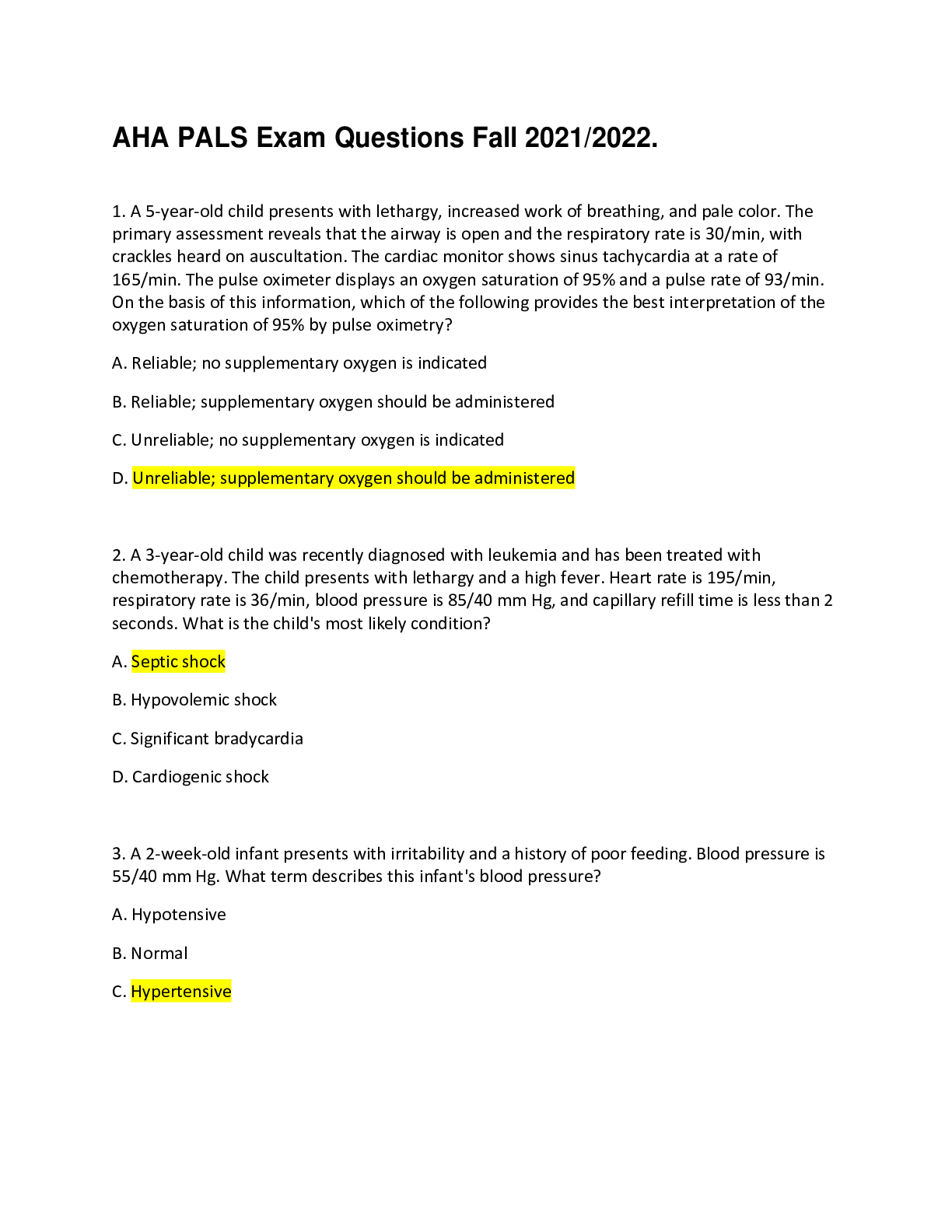

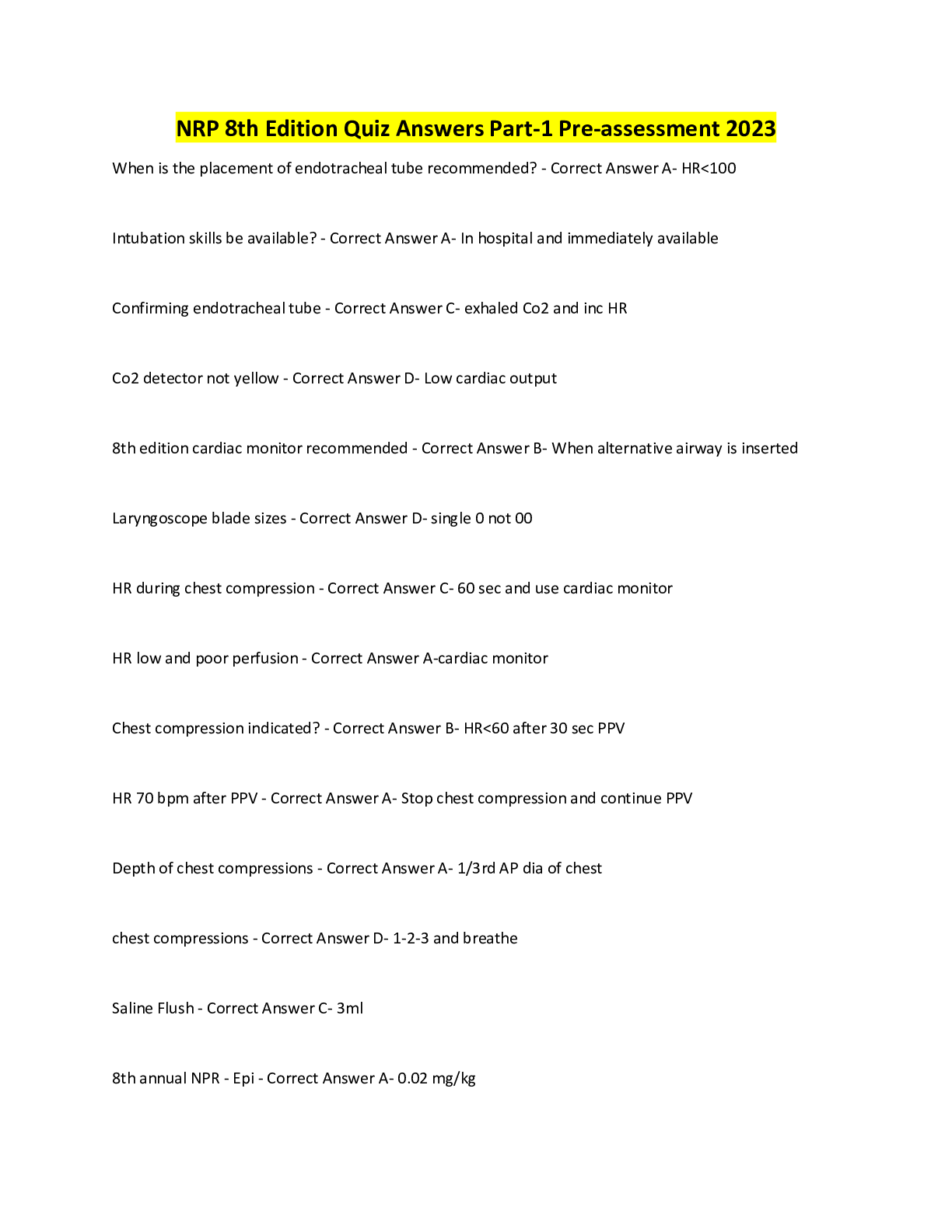

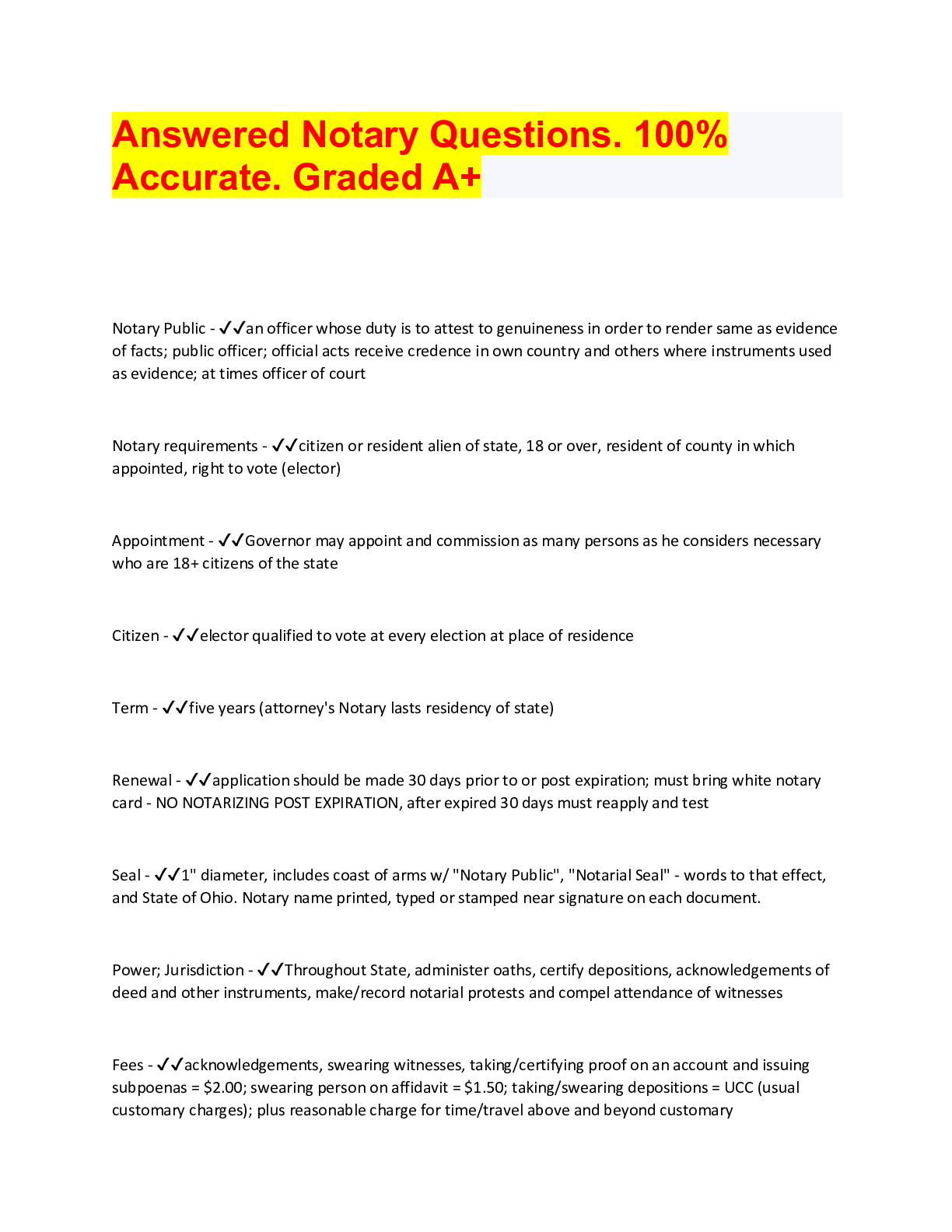

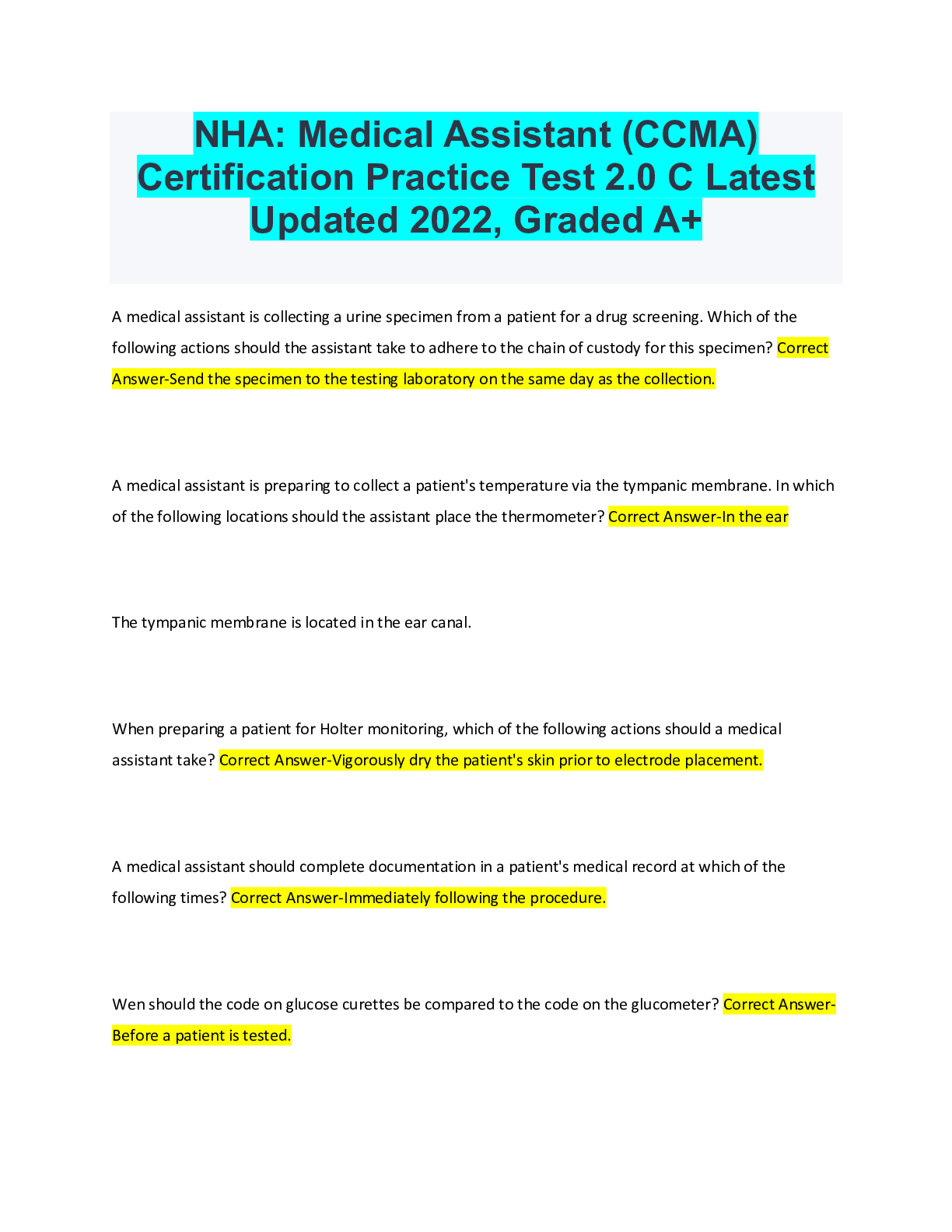
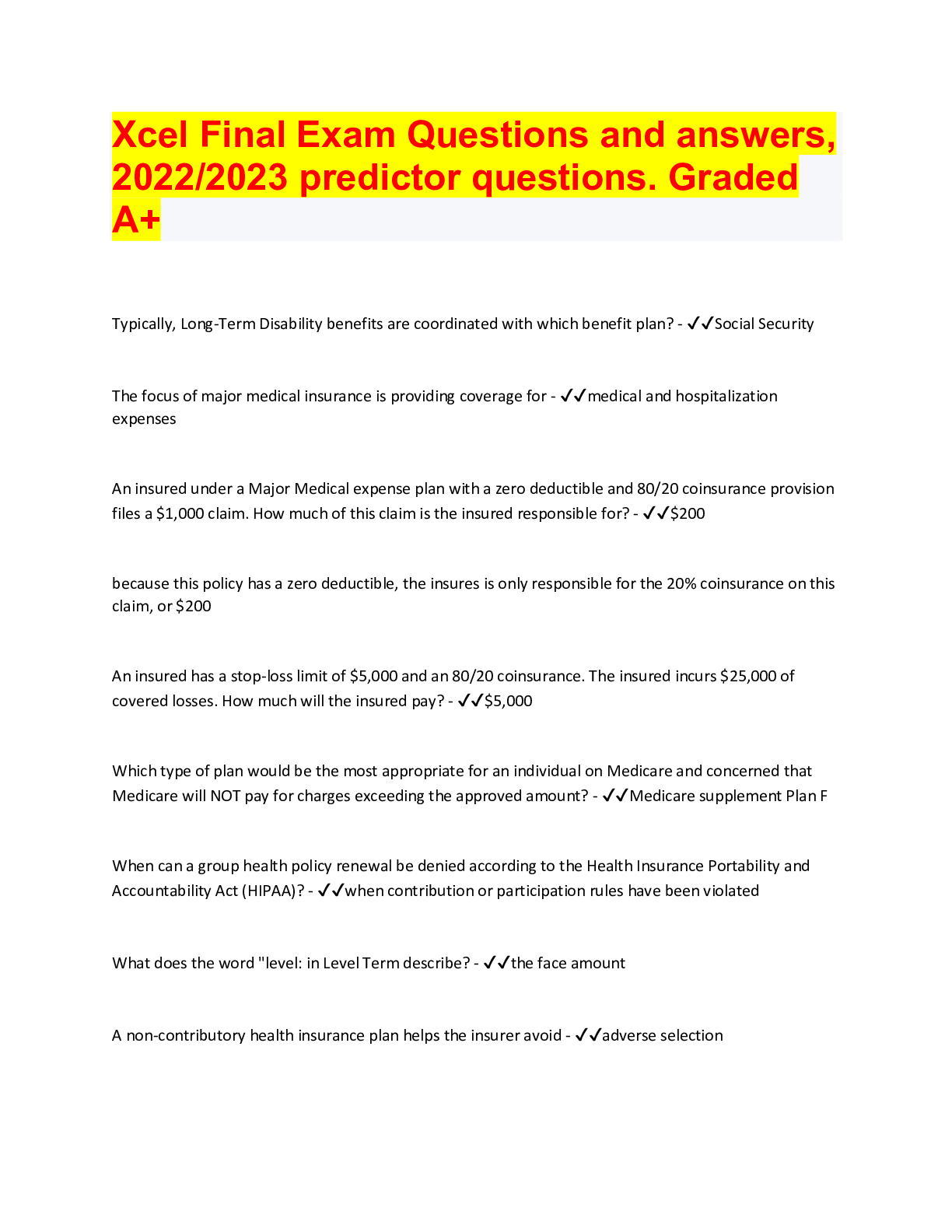
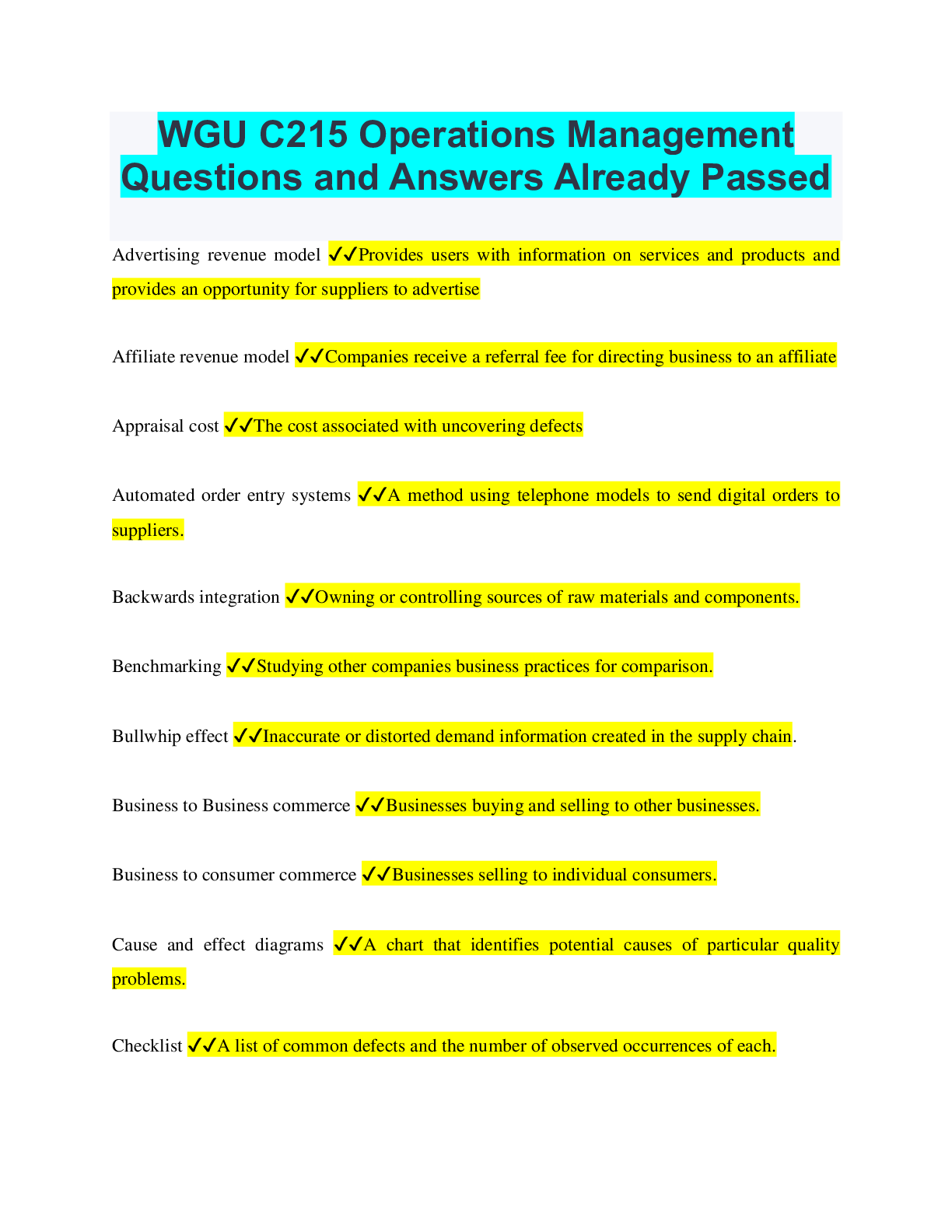
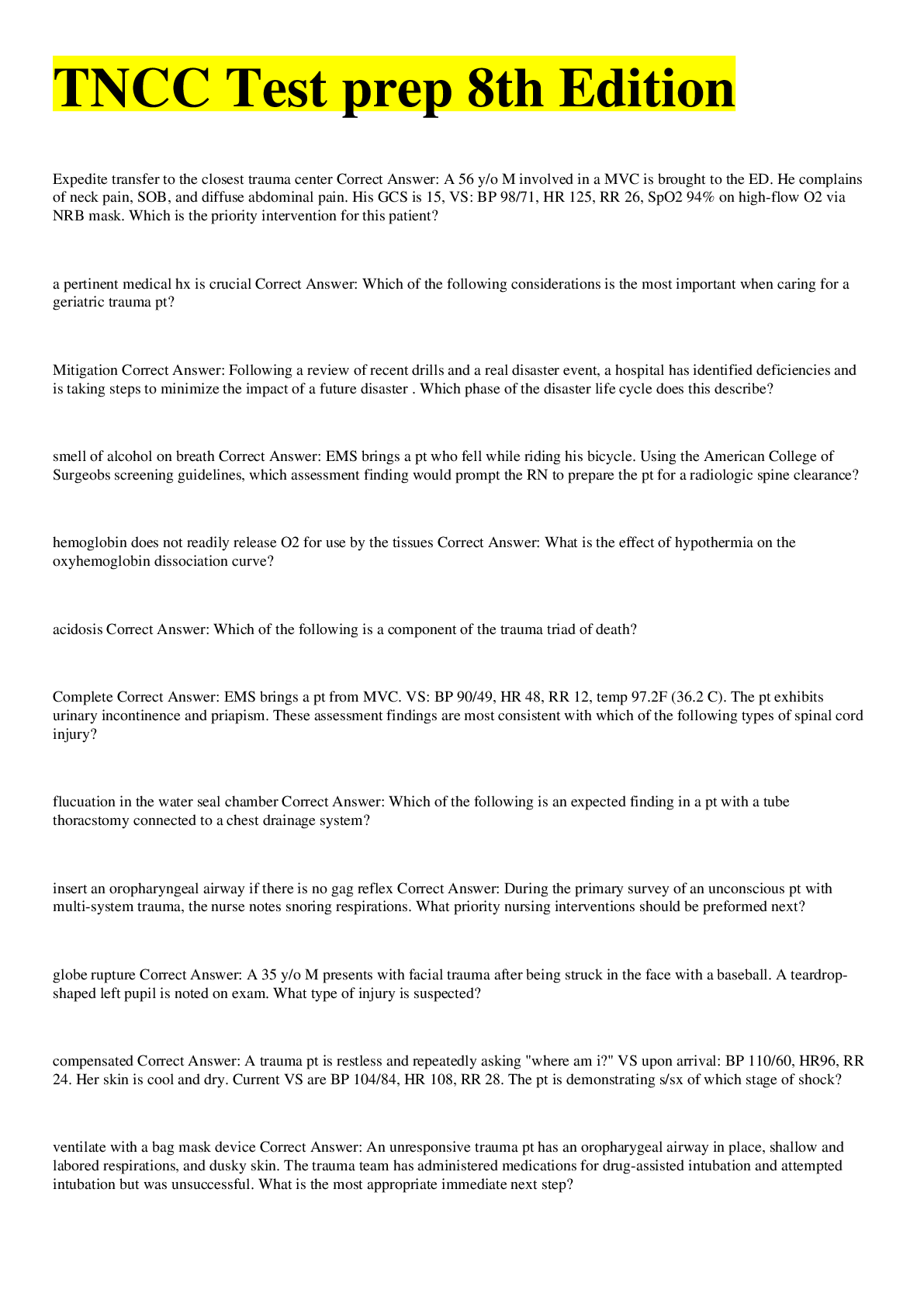
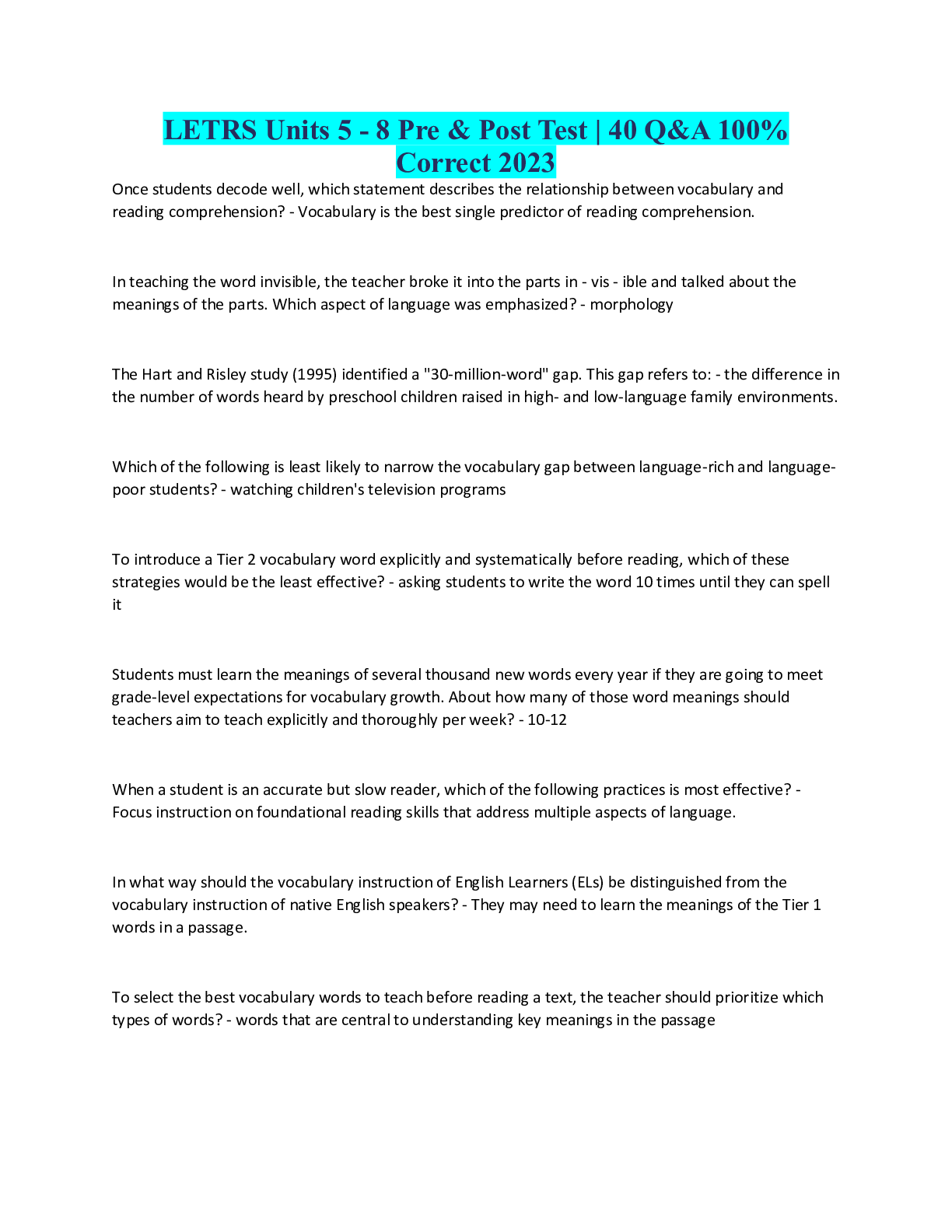
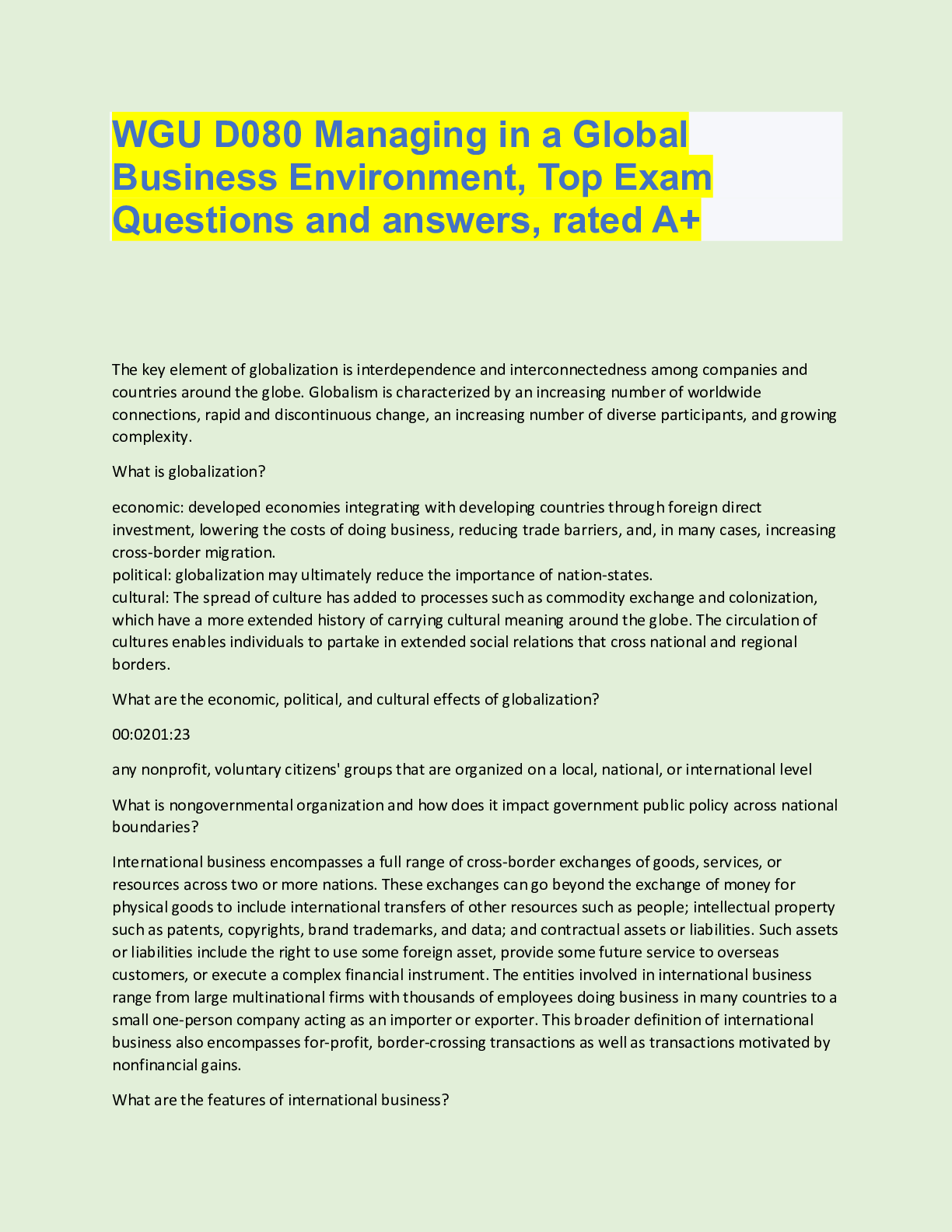
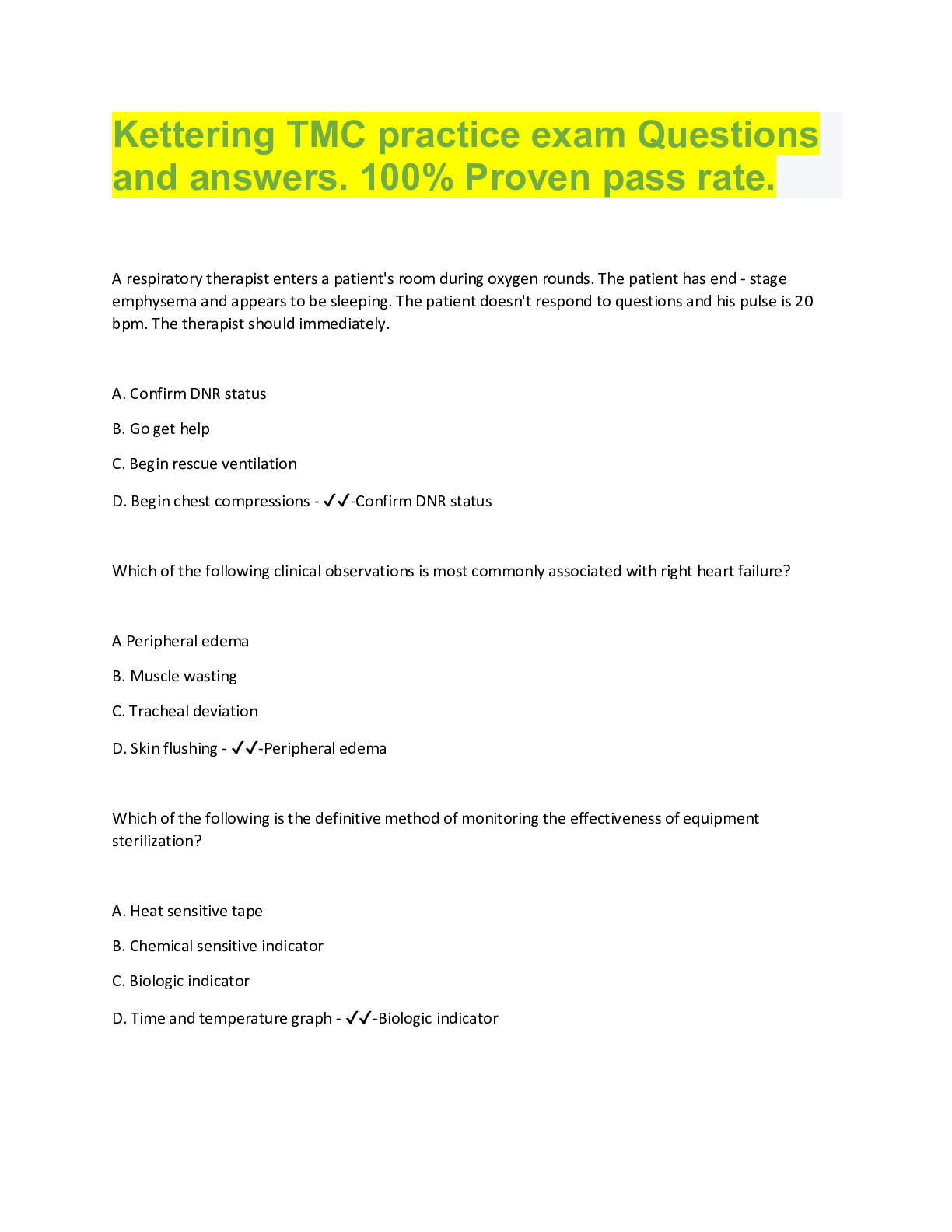
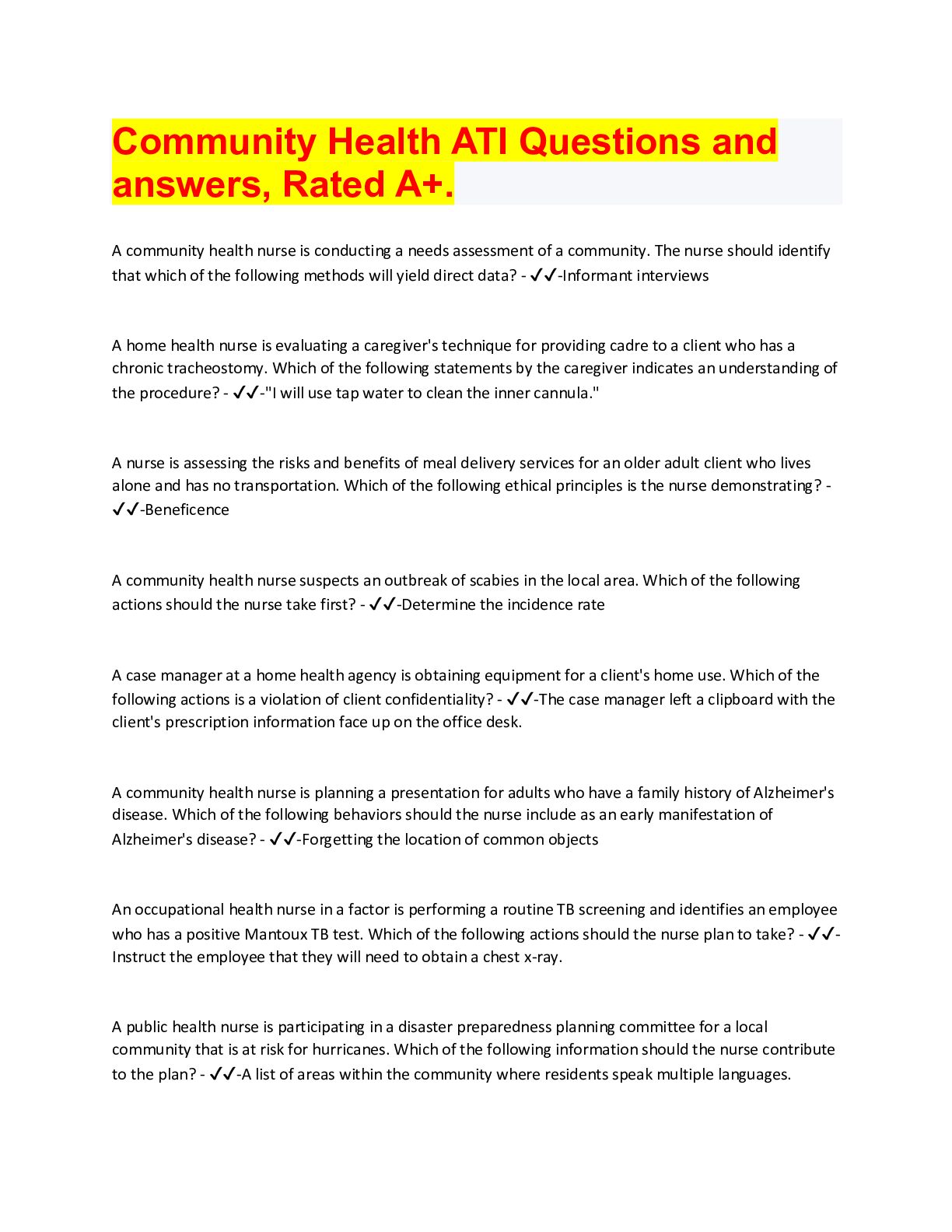
 (1).png)
